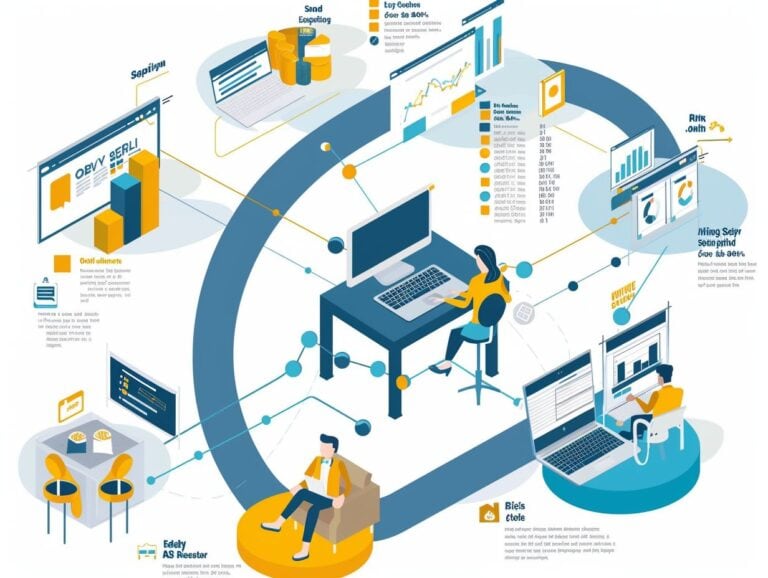- Our content is independently written and reviewed by trusted reviewers & fact-checkers.
- We can earn money by connecting you with top Gold IRA Companies. Learn how our reviews work.
- Want to learn more? Meet our authors and explore our editorial policy.
Thinking about setting up an ESOP for your company? Before diving in, it’s important to understand the basics of ESOP setup costs. From calculating the initial investment to assessing ongoing maintenance expenses, there are several factors to consider. But don’t let the costs deter you – the benefits of setting up an ESOP can outweigh the expenses. In this article, we’ll explore the financial advantages for the company, as well as the benefits of employee engagement and retention. We’ll also debunk common myths about ESOP expenses and provide realistic reasons to reconsider ESOP implementation. 
Table of Contents
Key Takeaways:
- Setting up an ESOP involves both initial and ongoing expenses, including legal and administrative costs.
- The cost of setting up an ESOP varies depending on factors such as company size, type of plan, and complexity of implementation.
- Despite the costs, an ESOP can bring financial benefits for the company and foster employee engagement and retention.
Understanding the Basics of ESOP
An Employee Stock Ownership Plan (ESOP), as per the definition provided by the Internal Revenue Service (IRS), is a qualified retirement plan designed to offer a company’s workforce an ownership stake in the business. This distinctive structure enables employees to participate in the company’s prosperity and financial success. By providing employees with a share in the company’s ownership, ESOPs cultivate a sense of collective responsibility and mutual concern for the organization’s performance. This can result in heightened productivity, enhanced job satisfaction, and reduced turnover rates within the workforce. ESOPs present substantial tax advantages for both the company and its employees, promoting enduring financial security. The regulatory framework established by the IRS ensures that ESOPs adhere to specified guidelines, thereby safeguarding the interests of all involved parties and guaranteeing transparency in ownership transitions and valuation procedures.
Factors Affecting ESOP Setup Costs
The establishment costs of an Employee Stock Ownership Plan (ESOP) in a company are influenced by several significant factors, which include valuation methods, financing options, and the intricacy of the transaction at hand. It is imperative for stakeholders to comprehend these factors thoroughly in order to make well-informed decisions regarding the implementation of an ESOP. Valuation methodologies are pivotal in determining the initial costs associated with setting up an ESOP. Businesses have the option of engaging independent appraisers to accurately assess the fair market value of the company. Furthermore, the chosen financing approach, be it through loans, seller financing, or a combination thereof, plays a critical role in determining the upfront expenditures involved. The level of transaction complexity, which encompasses aspects such as the number of participants, regulatory mandates, and legal expenses, can also exert an influence on the overall establishment costs of an ESOP. Proactively considering these variables can aid organizations in effectively planning and budgeting for their transition to an ESOP structure.
Calculating Initial Investment
In the process of establishing an Employee Stock Ownership Plan (ESOP), companies frequently engage professional appraisers to ascertain the fair market value of the business. This valuation procedure is pivotal in establishing the stock price and the financial commitment required from both stakeholders. Valuation experts evaluate a range of factors, including the company’s assets, earning potential, prevailing market conditions, and industry standards, to conduct a comprehensive assessment. Accurate determination of the fair market value allows companies to avoid paying excessively or undervaluing their shares, ensuring equitable terms for both the company and its employees. A comprehensive understanding of stock pricing and financial evaluations is crucial for the successful establishment of an ESOP that aligns with the company’s strategic objectives and aspirations. 
Assessing Ongoing Maintenance Expenses
Along with initial setup expenses, businesses should take into account the continuous maintenance costs related to the administration of an Employee Stock Ownership Plan (ESOP), such as legal fees, trustee services, and trust administration costs. It is crucial to ensure compliance with legal regulations and fiduciary obligations to secure the ESOP’s sustained success over the long term. Legal responsibilities play a fundamental role in protecting the welfare of employee-owners and upholding transparency in the operational aspects of the ESOP. Trustee services, involving the supervision of ESOP assets and the implementation of strategic decisions, also entail associated expenditures that companies must allocate in their financial planning. Similarly, trust administration costs encompass the day-to-day governance of the ESOP, encompassing activities like record-keeping, communication with participants, and activities related to compliance. These ongoing financial commitments can accumulate over the duration, underscoring the significance of prudent management of the ESOP maintenance budget by companies.
Benefits of Setting Up an ESOP
The implementation of an Employee Stock Ownership Plan (ESOP) presents a multitude of advantages for both the organization and its workforce. These benefits include tax efficiencies, heightened levels of employee engagement, and a sense of ownership that cultivates a collaborative and harmonious work environment. Such advantages play a pivotal role in fostering the long-term prosperity and continuity of the enterprise. Employees who possess a vested interest in the company’s performance by means of an ESOP exhibit a greater propensity for motivation and dedication towards attaining collective objectives. This heightened sense of ownership often translates into elevated levels of productivity and a deeper allegiance to the organization. ESOPs are also known to yield substantial tax advantages for both the company and its employees, thereby establishing a mutually beneficial arrangement. By aligning the interests of employees with those of the company, ESOPs engender a culture centered around shared triumphs and reciprocal gain.
Financial Advantages for the Company
One of the primary financial benefits for a company considering the implementation of an Employee Stock Ownership Plan (ESOP) is the potential enhancement of profitability through increased productivity, improved employee retention rates, and a stronger sense of ownership among employees. Carrying out a feasibility study is essential to evaluate the financial viability of transitioning to an ESOP framework. Feasibility studies play a critical role by offering a comprehensive assessment of the company’s financial well-being and its preparedness for the implementation of an ESOP. Through an examination of elements such as cash flow forecasts, debt capacity, and levels of employee engagement, organizations can make informed decisions regarding the feasibility and potential advantages of adopting an ESOP. This extensive evaluation can pinpoint areas where productivity enhancements are feasible, leading to an overall increase in profitability and ensuring the long-term sustainability of the business.
Employee Engagement and Retention Benefits
Employees are presented with a distinctive opportunity through an Employee Stock Ownership Plan (ESOP) to attain ownership in the organization they are employed by, fostering a sense of community, loyalty, and sustained commitment. This ownership interest not only enables employees but also instills a profound sense of pride and responsibility in their work. As owners, individuals are inclined to proactively engage, collaborate efficiently with peers, and propose innovative concepts to propel the company’s progress. The communal ownership framework of an ESOP nurtures a sense of comradeship among team members, urging them to provide mutual support and collectively pursue shared objectives. This collective mentality elevates workplace morale, enhances productivity, and fortifies overall employee contentment and retention. 
Drawbacks and Misconceptions About ESOP Costs
Despite the substantial benefits offered by ESOPs, there exist drawbacks and misconceptions concerning the costs and risks associated with the implementation and management of an ESOP. It is imperative for companies to address these myths pragmatically and assess the genuine implications before arriving at a decision. One prevalent misconception pertains to the notion that ESOPs consistently incur high expenses during establishment and maintenance. Although there are costs associated with initiating an ESOP, such as valuation expenditures and administrative fees, these expenditures may be mitigated by tax advantages and heightened employee engagement. Another misconception suggests that ESOPs constrain financial flexibility; however, with meticulous planning, companies can efficiently manage cash flow while simultaneously rewarding employees through ownership interests. A comprehensive understanding of the potential drawbacks and risks associated with ESOPs is essential to ensure a successful implementation.
Common Myths About ESOP Expenses
One common misconception surrounding ESOP expenses pertains to the perceived complexity and management challenges associated with maintaining an ESOP. However, by establishing proper governance structures and ensuring active employee participation, many of these perceived obstacles can be effectively addressed, facilitating a smoother transition and operational management. Incorporating a robust governance system and fostering a culture of transparency within organizations can significantly aid in navigating the complexities of ESOP implementation. Furthermore, employee involvement not only enhances organizational effectiveness but also cultivates a sense of ownership among staff members, thereby motivating them to contribute to operational efficiency. It is imperative to dispel the notion that ESOP expenses invariably lead to financial strain. Through prudent management and strategic planning, organizations can mitigate potential risks and optimize the advantages of employee ownership.
Realistic Reasons to Reconsider ESOP Implementation
Ahead of finalizing the decision to implement an Employee Stock Ownership Plan (ESOP), it is imperative for companies to conduct a thorough assessment of the risks, expenses, and potential long-term implications associated with such a transition. A comprehensive understanding of the effects on business operations, ownership structure, and community relationships is essential for the successful execution of an ESOP. Furthermore, companies must carefully evaluate the impact of an ESOP on employee morale, productivity, and retention. Engaging with key stakeholders, including employees, investors, and customers, is critical in obtaining support and aligning interests. Considering the legal and regulatory framework governing ESOPs, alongside seeking professional guidance on tax considerations and fiduciary duties, can assist in mitigating potential risks. Establishing a robust communication strategy to educate all stakeholders on the ESOP process and objectives is crucial for fostering transparency and building trust within the organization. 
Frequently Asked Questions
How much does it cost to set up an ESOP?
The cost of setting up an ESOP can vary greatly depending on a number of factors, including the size of the company, the complexity of the plan, and the involvement of outside professionals. On average, the cost can range from $20,000 to $50,000.
What are the main expenses associated with setting up an ESOP?
The main expenses typically include legal fees, valuation fees, and administrative fees. These costs can add up quickly, so it’s important to carefully consider the budget and expectations for the ESOP before moving forward with the process.
Are there any ongoing costs after the ESOP is set up?
Yes, maintaining an ESOP also involves ongoing expenses such as annual valuations, administrative fees, and trustee fees. These costs can range from $5,000 to $20,000 per year, depending on the size and complexity of the ESOP.
Can a company with a small budget still set up an ESOP?
Yes, even smaller companies can set up an ESOP. There are options for structuring the plan to fit within a smaller budget, such as using a pre-approved ESOP document or opting for a lower-cost valuation method. It’s important to work with experienced professionals to find the best solution for your company’s budget.
Are there any tax benefits to setting up an ESOP?
Yes, there are several tax benefits associated with ESOPs. For example, contributions to the ESOP are tax-deductible for the company, and employees can defer paying taxes on their ESOP distributions until they retire or leave the company. Additionally, if the ESOP owns at least 30% of the company’s stock, it may be able to get a tax deduction on dividends paid to employees.
Is it worth the cost to set up an ESOP?
The decision to set up an ESOP should be carefully considered based on the company’s goals and financial situation. While there are costs involved, an ESOP can provide significant long-term benefits, such as increased employee ownership and engagement, tax benefits, and potential for increased company value. Consulting with experienced professionals can help determine if an ESOP is the right choice for your company.










